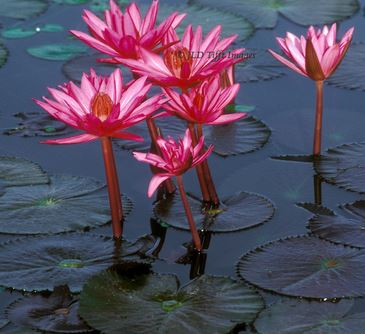Water Lily – shapla flower is the national flower of Bangladesh, an aquatic plant of the genus Nymphaea which has large, disk-like, floating leaves and showy flowers. There are about 50 species growing in different countries. In Bangladesh there are two species: N. nouchali (blue variety) and N. pubescens (white variety).
Water Lily grows in the soil under the water of lakes, canals, ponds in Bangladesh. The shapla flower blooms in the rainy season mainly. Bangladeshi people use shapla stalk in the curry.
Both species grow abundantly as a mixed population in almost all shallow natural water bodies, but the latter is more frequent and popular in Bangladesh.
Another species, N. rubra, is often cultivated in ponds and tanks as an ornamental plant. Each plant produces several solitary flowers with long peduncles and blooms above the water surface.
Shapla Flower
Water Lily Shapla is seen in abundance in the monsoon season. The peduncle is a popular vegetable to villagers; the tuberous rhizomes are also eaten. Seeds on frying are eaten as puffed-grains in some places.
The giant water lily or Amazon water lily (Victoria amazonica) is occasionally grown in some gardens for its enormous (about 2m in diametre) orbicular floating leaves.
There are different kind of Water Lily in Bangladesh are white , pink, red, yellow, blue, etc. White Shapla flower is national symbol of Bangladesh. Sada shapla flower is very much know and growing almost in every district of Bangladesh.
Heart shape leaves of white shapla flower
The leaves are more round than heart shaped, dark green. Bangladesh national flower leaves size from 15 cm to 30 cm in diameter with the slit about one-third the length of the leaf. Shapla flower Leaves usually float on the water’s surface beside the flowers.
Scientific Name of Shapla Flower
There are about 70 species of water lilies available all over the world. One of the genus is Nymphaea and it contains about 35 specis of water lily. Horticulturally water lilies are divided into 2 categories : 1) hardy and 2) Tropical. The shapla – water lily is an aquatic type flower.
Hardy water lilies can bloom during the day time only, but tropical water lilies can bloom either day or night.
National Flower of Bangladesh – Shapla flower

The water lily, known as “Shapla” in Bengali, is the national flower of Bangladesh, embodying the beauty, cultural heritage, and natural wealth of the country. As an emblem of purity and resilience, the water lily represents the intricate relationship between the natural environment and the cultural identity of Bangladesh. This essay delves into the botanical, cultural, ecological, and economic aspects of the water lily, highlighting its significance and the challenges it faces in the context of Bangladesh.
Botanical Characteristics
The Bangladesh National Flower belongs to the genus Nymphaea, which includes a variety of species renowned for their large, decorative flowers and floating leaves. The most prevalent species in Bangladesh is Nymphaea stellata, commonly referred to as the blue water lily. This species is celebrated for its striking blue petals and delicate, intricate structure.
The water lily’s botanical features are well-suited to its aquatic habitat. Its leaves, which are broad and circular, float on the surface of the water and are supported by long, flexible stems that extend to the roots anchored in the mud below. The flowers typically bloom in the early morning and close in the afternoon, a cyclical pattern that adds to the plant’s allure. The water lily’s ability to thrive in muddy, nutrient-rich environments underscores its resilience and adaptability.
Cultural Significance
The national flower of Bangladesh holds profound cultural significance in Bangladesh. It is not only a symbol of natural beauty but also represents spiritual and philosophical ideals. The flower’s ability to bloom elegantly in muddy waters is often seen as a metaphor for overcoming adversity and emerging with grace. This symbolism resonates deeply with the Bengali people, reflecting their cultural values and resilience.
In Bengali art and literature, the water lily is a recurring motif. It appears in traditional paintings, poetry, and folklore, often symbolizing purity and serenity. The flower’s image is also frequently used in local handicrafts and textiles, illustrating its pervasive influence in everyday life. During various cultural and religious festivals, water lilies are used decoratively in ceremonies and rituals, highlighting their importance in traditional practices.
Ecological Impact
The Bangladesh national flower plays a crucial role in maintaining the health and balance of aquatic ecosystems. Its large, floating leaves create a canopy over the water, which serves multiple ecological functions. By shading the water surface, the leaves reduce the penetration of sunlight, thereby limiting the growth of algae. This helps to prevent eutrophication, a process that can lead to the depletion of oxygen in water bodies and harm aquatic life.
The plant’s root system also contributes to the stability of aquatic environments. The roots anchor the water lily to the sediment, helping to prevent erosion and stabilize the soil at the bottom of ponds and lakes. This stabilization is essential for maintaining water quality and supporting the overall health of aquatic habitats. Additionally, the water lily’s presence provides habitat and food for a variety of aquatic organisms, including insects, fish, and birds.
Economic and Practical Uses
Beyond its ecological and cultural significance, the water lily has practical and economic value in Bangladesh. In rural areas, the plant is harvested for various uses. The flowers and leaves are utilized in traditional medicine, where they are believed to possess therapeutic properties. The water lily is also used in local crafts and decorative arts, adding aesthetic value to products and contributing to the local economy.
The presence of water lilies in ponds and lakes enhances the visual appeal of these natural spaces, which can attract tourists and promote ecotourism. This, in turn, provides economic opportunities for local communities and encourages the conservation of natural habitats. By fostering a connection between tourism and environmental preservation, the water lily contributes to sustainable economic development.
Conservation Challenges
Despite its importance, the water lily faces several challenges that threaten its survival and the health of its habitats. Pollution is a significant concern, as agricultural runoff, industrial discharge, and plastic waste can degrade water quality and harm aquatic plants. The introduction of pollutants into water bodies can lead to nutrient imbalances and negatively impact the growth and health of water lilies.
Habitat destruction is another major threat. Urbanization, land reclamation, and infrastructure development can result in the loss of wetlands and aquatic environments where water lilies thrive. Climate change also poses risks, as changes in temperature and precipitation patterns can alter the conditions of aquatic habitats and affect the distribution of water lilies.
Efforts to conserve the water lily and its habitats are crucial for ensuring its continued presence in Bangladesh. This involves addressing pollution sources, implementing sustainable land-use practices, and protecting natural wetlands. Public awareness and education about the importance of water lilies and their ecosystems can also play a role in conservation efforts.
Culinary Uses
In Bangladesh, the water lily is not just an ornamental plant but also has culinary value. The lotus, or water lily, is used in various traditional dishes, reflecting its integration into the local diet. The edible parts of the water lily, particularly the rhizomes (underground stems) and seeds, are used in cooking.
The rhizomes, known locally as “Shapla Kachori,” are often boiled or stir-fried and added to dishes for their crunchy texture and mild flavor. They are typically used in curries, soups, and salads. The preparation of these dishes involves peeling and slicing the rhizomes, which are then cooked with spices and other ingredients to enhance their taste.
Water lily seeds, on the other hand, are often roasted and used as snacks or added to sweet and savory dishes. These seeds are rich in protein and other nutrients, making them a healthy addition to the diet. In traditional medicine, water lily seeds are also believed to have various health benefits, including improving digestion and enhancing skin health.
Decoration
The water lily’s role in decoration is significant, particularly in cultural and religious contexts. Its aesthetic appeal makes it a popular choice for embellishing homes, public spaces, and during festivals. The flower’s vibrant colors and elegant form lend themselves to a variety of decorative uses.
During religious ceremonies and cultural festivals, water lilies are used to adorn altars, homes, and community spaces. Their presence in these settings symbolizes purity, beauty, and the divine. In rural areas, water lilies are often floated in bowls of water or arranged in decorative patterns for special occasions.
In art and crafts, water lilies are a common motif. They appear in paintings, embroidery, and textiles, reflecting their symbolic and visual appeal. Artisans often incorporate the flower into traditional designs, using it to convey themes of beauty and natural harmony. The lotus is also featured in various forms of traditional Bangladeshi art, including pottery and sculpture.
Classification in Bangladesh
In terms of classification, the water lily falls under the broader category of aquatic plants and has a specific classification within botanical and cultural frameworks. Botanically, it belongs to the genus Nymphaea and the family Nymphaeaceae. There are several species within this genus, but the Nymphaea stellata is particularly prominent in Bangladesh due to its striking blue flowers and suitability to the local climate.
Botanical Classification:
- Kingdom: Plantae
- Order: Nymphaeales
- Family: Nymphaeaceae
- Genus: Nymphaea
- Species: Nymphaea stellata (Blue Water Lily)
Cultural and Ecological Classification: In Bangladesh, the water lily is classified not just botanically but also culturally and ecologically. Culturally, it is classified as a symbol of national pride and beauty. Its role in traditional practices and its depiction in art and literature elevate its status beyond mere flora.
Ecologically, the water lily is classified as an essential component of freshwater ecosystems. It is commonly found in ponds, lakes, and slow-moving rivers throughout Bangladesh. Its presence is indicative of a healthy aquatic environment, as it helps in regulating water quality and providing habitat for various aquatic species.
Incorporating the Bangladesh National Flower as a Monogram in Government Offices
The water lily, or “Shapla,” is the Bangladesh National Flower and holds profound significance as a symbol of purity, resilience, and natural beauty. Integrating this iconic flower into the monogram of the People’s Republic of Bangladesh office can enhance the aesthetic appeal and reflect the country’s cultural values and identity. Here’s how the water lily can be effectively used as a monogram in various settings within government offices:
1. Official Documents and Stationery
One of the most prominent uses of the water lily as a monogram is on official documents and stationery. Incorporating the Bangladesh National Flower into letterheads, envelopes, and official forms can symbolize the connection to the national identity and enhance the prestige of these documents. The monogram can be designed to include the water lily in a stylized form, either as a subtle background element or as a prominent feature. This use not only adds a touch of elegance but also serves as a constant reminder of the national flower’s significance.
2. Office Signage and Branding
Incorporating the water lily into office signage and branding materials is another effective way to use the national flower. Monograms featuring the Bangladesh National Flower – Shapla full can be prominently displayed on the entrance signs, directory boards, and other office signage. This integration helps in reinforcing the brand identity of the government office and underscores the importance of national symbols in everyday administrative functions. The monogram can be designed to reflect the formality and authority of the office while incorporating the delicate beauty of the water lily.
3. Interior Design and Decor
The water lily as the Bangladesh National Flower can be used as a monogram in the interior design and decor of government offices. This includes incorporating the flower into wall murals, decorative panels, and furnishings. For example, the water lily monogram can be featured in a mural in the lobby or conference rooms, providing a visually appealing and culturally relevant focal point. Additionally, custom-designed carpets, curtains, and upholstery with subtle water lily patterns can contribute to a cohesive and dignified office environment.
4. Ceremonial and Commemorative Items
The water lily monogram can be used on ceremonial and commemorative items such as plaques, awards, and gifts presented during official events. These items can feature the monogram as a symbol of national pride and excellence. For example, awards and certificates presented by the office can include the water lily monogram to reflect the significance of the occasion and the office’s connection to national symbols.
5. Digital Presence
In the digital realm, the water lily monogram can be integrated into the office’s website and digital communications. This includes using the monogram in email signatures, digital letterheads, and social media profiles. By incorporating the water lily into the digital branding, the office can maintain a consistent visual identity that aligns with the national heritage and reinforces the cultural significance of the flower.
6. Employee Uniforms and Badges
The water lily can also be used in the design of employee uniforms and badges. Incorporating the monogram into uniforms, name badges, and other employee accessories helps to unify the staff and promote a sense of pride in the national symbol. The monogram can be embroidered onto uniforms or printed onto badges, ensuring that the water lily is a visible and integral part of the office’s daily operations.
7. Public Relations and Outreach
Finally, the water lily monogram can be used in public relations and outreach materials, including brochures, reports, and presentations. By featuring the monogram on these materials, the office can effectively communicate its commitment to national values and enhance its public image. The monogram can serve as a reminder of the office’s connection to the nation’s cultural heritage and its dedication to upholding national symbols.
The water lily, or “Shapla,” is more than just a national flower of Bangladesh; it is a symbol of the country’s natural beauty, cultural heritage, and ecological wealth. Its striking appearance, cultural significance, and ecological role underscore its importance in the context of Bangladesh. While the water lily faces challenges from pollution, habitat destruction, and climate change, efforts to conserve this remarkable plant are essential for preserving the health of aquatic ecosystems and maintaining the cultural and economic benefits it provides. By valuing and protecting the water lily, Bangladesh can continue to celebrate and nurture this cherished emblem of its natural and cultural heritage.










